Whenever I post about blogging on LinkedIn, I get comments and DMs asking if blogging and SEO are still worth it.
Blogging is dead.
Blogging is so 2023.
Blogging doesn’t bring any results after Google updates.
How to succeed in blogging when the blogging landscape is ever so turbulent?
Correction—Blogging isn’t dead; it’s evolving.
I agree that the updates and constant changes have made it challenging for many to create successful blogs.
What worked in 2023 may not apply in 2024. That’s why many people say blogging is dead when what’s dying is the old way of blogging.
So, if you’re one to believe any of the statements I mentioned earlier, I wrote this article to show you the power of blogging in the changing scenario of content marketing.
Here’s my blog’s performance over the last six months. As you can see, my performance rose and then dropped suddenly. Thankfully, I’m recovering now, thanks to the changes I made to my blogging efforts.
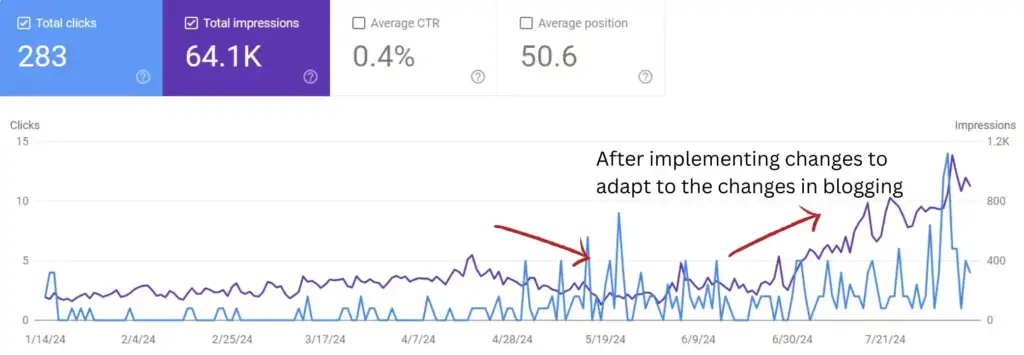
It also helped me get 30+ sales for my first digital in less than a month of launching it.
So, let’s see how you can succeed in blogging in 2024 and beyond amidst all algorithm changes.
Blogging is Changing
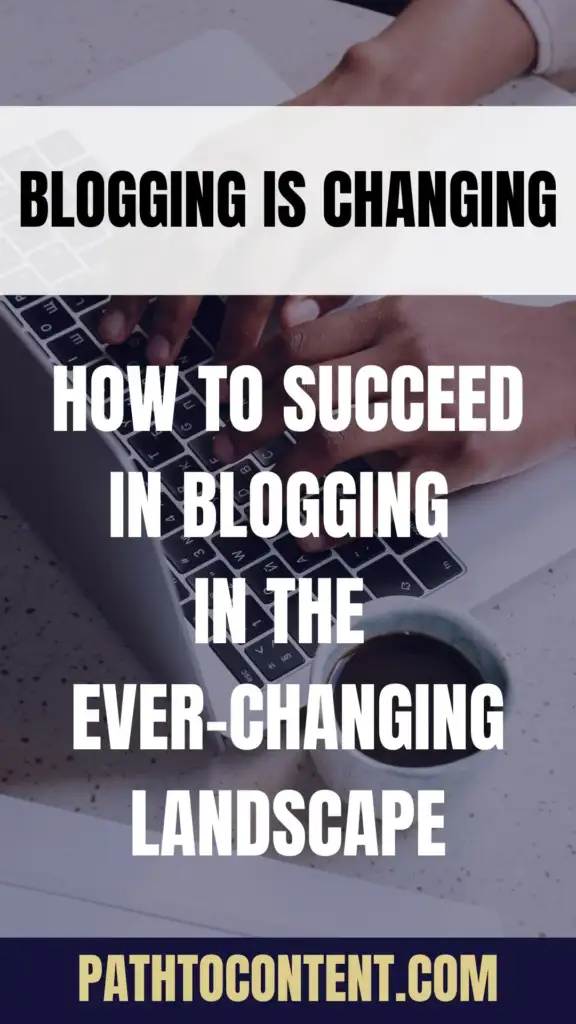
Every blogger who got into it had one goal: to rank on the first page of Google, get good traffic to their blog, and use ads to monetize that traffic.
It worked amazingly for bloggers to earn a significant passive income over the last decade.
But things are changing. The very ad revenue that was once a piece of cake has now become the most competitive method of earning through blogging.
Whatever niche you’re in, you need to be at the top of the game to convert the traffic into substantial ad revenue. To earn $100, you need more traffic than you needed back in 2020. It’s a cut-throat race to be at the top, especially in niches such as marketing, content, etc..
Google’s insider workings don’t help. Even if Google doesn’t agree, we all know how Google prefers the giants in every niche who have been in the game for ten or more years to rank at the top.
So, getting to the top and earning enough to continue blogging is no child’s game.
Not just that, you need to have an SEO-optimized website that looks professional, has optimized loading time, has quality backlinks, follows E-E-A-T guidelines, and much more. If you miss any of it, you can lose the top spot.
Impact of AI on Blogging Success

Both the AI used when creating content and the Generative AI Google uses to generate answers negatively impact blogging results.
Due to the generative AI Google uses, zero-click searches have increased significantly. The aim for bloggers is to get featured in the GenAI results. But that’s not possible for every post you publish.
Also, if you’re overly relying on AI to create blog content, you’d have noticed how that hits hard soon after you’ve published the content.
The recent Google updates also made it difficult to get your posts indexed if they contain a lot of AI content.
You see what I want to say here?
Overall, things are changing too much too fast. But there’s a silver lining to all the negativity surrounding blogging.
Let’s see how you can get past all the limitations, avoiding bloggers seeing the results they expect.
How to Succeed in Blogging in 2024 (Create a Successful Blog The Right Way)
Branch out your traffic sources (Don’t just rely on Google)
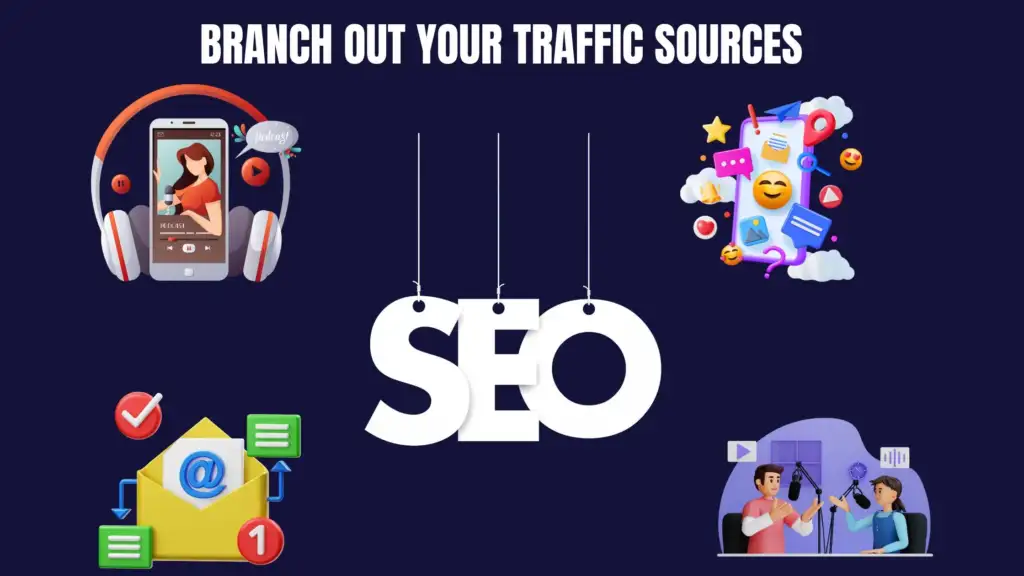
I’ve always said that SEO alone won’t help new websites. The Google Sandbox is real, and new websites aren’t easily ranked in their early stages. That makes perfect sense.
SEO is a big game. You can’t just come and think of conquering it in a few months.
But that also doesn’t mean you shouldn’t do anything.
The answer is to branch out outside SEO and search engines—marrying SEO with social media marketing.
Before launching this website, I started building my brand on LinkedIn. This continues, and organic social is my second biggest source of traffic after organic search. I’ve also started using Pinterest to support the organic social traffic from LinkedIn.
This is how to break into the traffic game—having a uniform and strong presence on at least one social platform besides SEO.
Also, thinking outside of SEO and search engines doesn’t only apply to new sites. Even experienced sites and businesses shouldn’t rely on only one channel, especially with all the mood swings Google’s going through (just kidding).
But yes, Google’s changing a lot and will keep changing. Relying only on SEO is letting your potential go in vain when equally powerful traffic sources are available.
That way, you can still get organic and, most importantly, relevant traffic and sales from your website. The social traffic also signals Google about your authenticity, which helps you move out of the sandbox faster.
Maximize Product Income
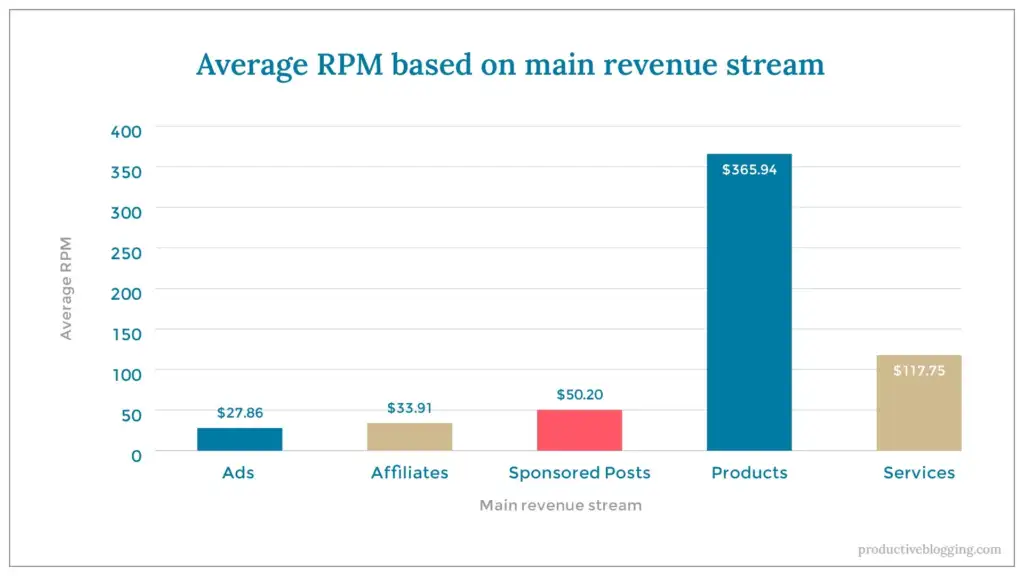
A survey by Productive Blogging showed that the biggest share of blog revenue comes from product income.
Consider other blog monetization channels: Ads, affiliates, and sponsorships. All of these involve relying heavily on someone who isn’t you.
You need enough traffic to get ads to pay you. You need quality affiliates and targeted traffic to get visitors to click the affiliate links. Not to forget, Google penalizes affiliate sites more easily than service/product sites.
Sponsorships are no different. They require efforts to create content each time you want to sponsor a brand.
Now, think of products—be that a retainer offer for clients, a one-off digital product, or a subscription model. As long as you promote the products correctly, you only have to invest once and enjoy the ROI.
Diversify your service into multiple products such as eBooks, video recordings, consultations, retainer services, courses, cohorts, etc.
Believe me, if you create quality content for these products, your blog will only thrive with profits.
Build A Strong Email List (Create Revving Fans)
You can lose thousands of followers on social media with one ban or unacceptable activity.
You can lose your website traffic with one Google update.
But what you don’t lose? An audience you own.
Common advice to build an audience you’ll never lose: Start a newsletter.
Similar to content you publish elsewhere, newsletters must be a valuable investment of the readers’ time. The aim is to get subscribers but also never to see anyone unsubscribe.
Additionally, when you have digital products or services to promote, you can use email newsletters to send sales emails from time to time. You can also simply promote your services as a common CTA for all your email newsletters.
Your email subscribers willingly share their email IDs to become invested readers of your content. These emails won’t go unnoticed as your readers volunteered to read more from you.
When you have such revving fans, converting them into buyers is only a matter of time.
| Suggested Reading: 32 Best Blogging Tools
Know Your Strong Fronts
Whatever service you offer, there’s always something that you’re the best in. Think of the times your clients appreciated your work. What was the common repetition mention you heard?
For example, though I started as an SEO writer and then expanded to offer LinkedIn branding, my strategy for strategizing content was what my clients liked the most.
It landed me on my strongest front—content strategy. I’m not in the works of updating my services to focus on content strategy.
Similarly, there will be something that’s your USP. A sub-service under your primary service that makes you different from your competitors.
Leverage that. Since it’s what you do the best and your clients like it the most, you’ll be able to offer unique and better results. It’ll become your differentiator and help you land clients faster.
It’ll also make your digital products or lead magnets unique from what’s already available.
Remember, with great uniqueness comes great scope for growth.
Increase Sales Touchpoints
When I joined LinkedIn in 2022, it was still quiet, with few content creators selling their services.
In the last year, however, the picture has changed.
The same is true of blogging. Many new bloggers have joined after the benefits of blogging became evident.
This has led to content saturation. This saturation brings mediocrity.
When everyone sells the same service, it becomes difficult to stand out.
Then what’s the solution?
Increasing touchpoints.
When you do something extra, you beat your competition. Increasing my touchpoints has helped me reach an audience outside of LinkedIn and blogging.
Most importantly, now I can connect to this audience without relying on the ever-changing algorithms.
Here’s what I mean when I say create more touchpoints independent of the platform:
Touchpoint 1: Create Lead Magnets
I had created a couple of lead magnets earlier, but they didn’t make my audience take the next step—book a consultation call.
What I did wrong: Created lead magnets on generalized topics.
When I listened to what my audience was saying, I created the lead magnet that’s generating bookings.
Don’t just create something for the sake of doing it. Find the most common problems your audience faces.
You can find the problems through:
- Comments on your posts
- Questions asked in DMs
- The problems you faced when you were in their position
Make the resource top-notch.
Don’t forget to add a CTA that leads them to your offer.
Note: Even if the audience doesn’t act on the CTA, you’ve still got their emails.
Now, you don’t have to rely on the grace of the algorithms to reach the audience.
You can slide into their inbox anytime with a promotional email, a testimonial feature, a special offer price, etc.
Basically, now you won’t be left unnoticed.
Touchpoint 2: Build a website
Even if you don’t have a blog, doing SEO right can get your website ranked for the BOFU keywords (the ones that bring sales).
Another advantage of having a website is creating a premium experience. When you do cold outreach, having a professional website automatically makes you stand out.
Plus, your prospects can find all the answers about the service, pricing, and deliverables in one place.
| Suggested reading: Impacts of SEO mistakes and how to avoid them
Note: Again, promoting your lead magnets on the website can get you email subscribers, if nothing else. That’s still a win because you’re already promoting your services there.
Touchpoint 3: Create a sales funnel
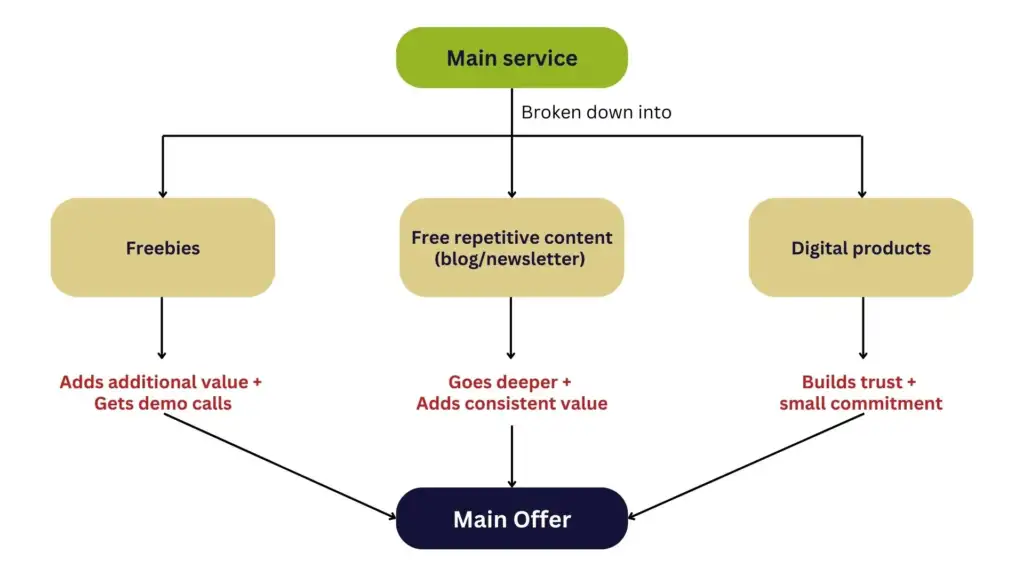
When they find you, most of your audiences are not in the buying stage; they are in the learning stage, understanding different services before finalizing the one for them.
Some are even unaware that they need your service.
Attract all audiences at different stages through a sales funnel.
The easiest way to approach it is to break down your one-complete service into small, non-commitmental offers.
For example: If I’m offering SEO strategy service, I can create:
- Freebies about using a certain SEO tool
- Free blog tools
- Paid Digital product with templates to conduct SEO research
- Newsletter to share weekly SEO news/updates
And I’ll cross-promote each product.
You see, the same offer and the same content, just distributed into multiple touchpoints, gives you that extra edge over others.
Now, you can have a diverse source of acquiring an audience and multiple routes and chances to sell.
Attract Readers To Your Blog Faster
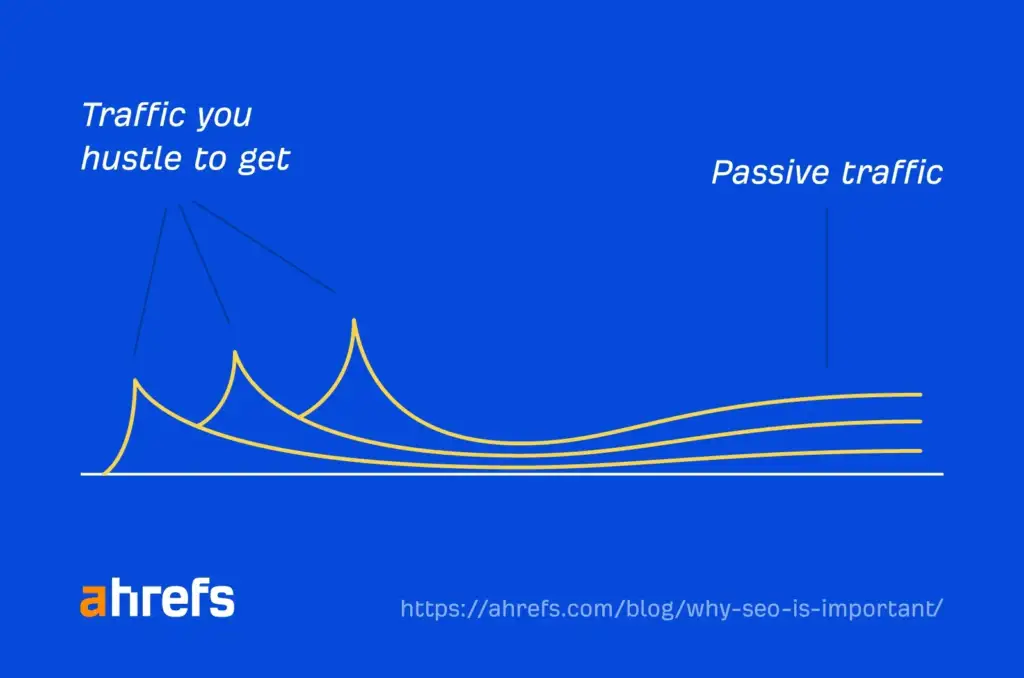
Getting that early traffic to your newly published posts creates a signal to search engines that it’s worth ranking. That initial spike of visits is crucial for your content.
Use social media and email marketing to get early attention on your blog posts. Promote them with blog blurbs. Create videos, infographics, simple text posts, etc.
Another way to get an audience faster is through SEO. Target low-competition keywords as they are easy to rank higher.
Utilize content pillars, topical content, and internal linking to show your audience and the search engines the structure of your site. It helps increase your ranks as search engines understand how you help your audience.
Send email blasts focusing on the takeaways from recently published posts, adding a CTA to encourage readers to visit the blog post.
Keep Your Audience Coming For More
Attracting an audience to the blog is only the first step. Converting them into recurring readers is the real challenge. Here’s what it needs to build a loyal audience:
1. Deliver consistent value through high-quality content
Content keeps the blogging boat afloat. Prioritize quality over quantity.
If you can only publish two blog posts each week, that’s fine. Don’t miss those two days. Even eight blog posts a month can bring you the right traffic and revenue when done right.
But for new blogs, quantity is equally important to quality. In that case, you can always outsource content writing to help you generate content faster.
2. Publish relevant and up-to-date content.
Keep your content fresh and exactly what your readers want to read. Follow the search intent to a tee. When new readers see your blog answering all their questions, they start trusting you, which leads to a consistent visit to your blog.
3. Create content series or write on one topic per month
This is something I follow. I select a topic cluster for a month and publish posts that fall into that cluster.
For example, if the topic cluster is on email marketing, that’s the content I publish that month. It helps build authority and creates a link between posts to keep readers coming for more.
4. Use email newsletters to stay top-of-mind
We already discussed email newsletters earlier in this post. A blog blurb or promotional post right after it goes live helps remind readers you’ve published new content.
You can also go for email segmentation to reach a targeted group of readers.
5. Seek out and act on feedback
Use email newsletters, polls, questions, etc., to ask your consistent readers what they’d like to read about. Create content on those questions or topics.
It shows your readers that you care and instills a sense of belonging.
Use Sponsorship And Affiliates Smartly
Wrongly handling sponsorships and affiliates can backfire quickly. Readers run away from advertisers who shout out their lungs without offering value.
Only accept sponsor partnerships with brands that align with your brand and the needs of your audience.
For example, if your target audience consists of content creators, collaborating with an accounting or bookkeeping brand makes sense, as your audience may need these services.
Secondly, integrate promotion seamlessly into your content. Don’t go all in on advertising without following a content-first approach.
Only add promotional links in the content where they make sense. To add depth to the promotional content, create detailed reviews or case studies.
Be open to your audience about using affiliates and sponsorship content. Don’t create positive reviews only to promote affiliate partners. Be honest in the review. Care for your audience, and you’ll yield the results.
Network Smartly To Work Less
Collaboration is the new cool in the content landscape. Smart collaborations help you climb the success ladder quicker, while poor collaborations make you repeat the same steps repeatedly.
To create the right collaborations, create an active and useful network of creators. You can use your existing network to expand or start from scratch. LinkedIn, Instagram, X, etc., are great places to find talent in every niche.
Connect with like-minded people in niches that align with yours. These people can provide guest blogging and social media collaboration and even help you land clients.
Know The Purpose Of Each Post
Not every blog post is created the same. You can’t write each post with the same purpose.
Posts written to rank are different from posts written to land clients.
An integral share of blogging success depends on knowing the purpose of each blog post. Only then can you think of making your blog a success, right? Know the purpose of each post and create content briefs and outlines accordingly.
The most common purposes include:
- Driving traffic
- Building authority
- Engaging audience
- Generating leads
- Supporting sales
These objectives decide how you’ll craft each post. For example, SEO-driven posts focus on getting the factors to rank on the first page right. On the other hand, client-landing posts might not rank but showcase perfectly how you’ve helped previous clients using case studies.
Based on these factors, your posts will land at different levels of the customer journey and buyer’s funnel, and your ways of measuring success will also differ.
How To Become A Successful Blogger Even When You Don’t Have Any Experience
- Start with a clear purpose and niche.
- Learn the basics of blogging and content creation. You can’t skip the fundamentals.
- Start small and gradually build. But always keep your ultimate goal in mind when creating your roadmap.
- Build a content plan and stay consistent.
- Get more people to read your blog by promoting it.
- Be Patient and Persistent. It takes time. Don’t rush the process.
- Learn and Adapt as You Grow. We started this blog post with the same point. Blogging is constantly changing. Being rigid with the old ways won’t help. Keep adapting to change.
Pin this to save and read later

Steps Ahead: Want To Start A Successful Blog?
I believe you now know that blogging isn’t dead; it’s only evolving. Changing yourself to adapt to new blogging methods is the only way to succeed in blogging.
Implement the steps in this blog post, and you’ll have a successful blog.
Want to make creating a successful blog even easier? Let me help you develop a blog SEO strategy tailored to your brand needs.
From creating rankable content that meets goals to developing an entire blogging strategy—I’ve managed different roles as a freelancer. I’d love to help you, too!
Book a 1:1 discovery call now!



